Our brains have the remarkable capacity to adapt and change throughout our lives. This ability to form and reorganize neural pathways in response to learning, experience, injury, disease, or aging is called neuroplasticity.
“Everybody can be great, because everybody can serve. You only need a heart full of grace, a soul generated by love.”
~ Dr. Martin Luther King
Neuroplasticity helps the brain process sensory input along with creating suitable adaptive responses to stimuli. Neurons must have purpose to survive, and those with weak or ineffective connections are pruned. Through a variety of structural and molecular mechanisms, neurons compensate for injury or disease.
The process of developing and pruning connections enables the brain to adapt to the environment. Here’s the interesting part: We have a great deal of influence over the process of neuroplasticity. Whatever we repeat becomes stronger, while the things we neglect fade away. This applies not only to skills such as learning a language or a musical instrument, but also to emotions and personality traits. For example, major depression and anxiety have been described as a disorder of neuroplasticity.
Nobel laureate Eric Kandel said, “Neuroplasticity is what endows each of us with our individuality.”
Neuroplasticity at the Molecular Level
At the molecular level, neuroplasticity can be observed as increased expression of synaptic proteins and neurotrophic factors, such as brain derived neurotrophic factor (BDNF), that lead to neurogenesis and sprouting or remodeling of spine and dendritic architecture.1 Neurotrophic factors (NTFs) play an important role both in brain development and in adulthood by adjusting axonal and dendritic growth and remodeling, neurotransmitter release, and synapse formation and function.2-4
The brain comprises only 2% of total body weight, but consumes an astonishing 20% of the total energy derived from nutrients.5 Reactive oxygen species are produced in the body as a result of normal metabolic processes. While the brain has high metabolic demands, it has low antioxidant capacity. This contributes to oxidative stress of the central nervous system (CNS) because these reactive oxygen species damage proteins, DNA, and lipids.6 Oxidative stress contributes to aging and the pathogenesis of neurodegenerative diseases. NTFs support neurons against various neurodegenerative conditions, while alterations of NTF expression, including BDNF, is a factor in neurodegenerative disorders (Alzheimer’s disease, Parkinson’s disease, Huntington’s disease, and amyotrophic lateral sclerosis) as well as psychiatric disorders (depression and schizophrenia).7-9
Underlying the ability to tolerate the age-related changes and disease related pathology in the brain without developing clear clinical symptoms is a concept called ‘reserve.’ Brain reserve refers to structural differences that increase tolerance to pathology, whereas cognitive reserve refers to variability in approach to task performance.
According to the reserve hypothesis, impairments in cognition manifest after a pool of brain and cognitive resources is depleted. Studies show that the occurrence of dementia is lower in those with larger brain weights and that those who engage in intellectually stimulating activities experience less hippocampal atrophy with aging. Individuals with decreased brain or cognitive reserve are more likely to exhibit clinical impairments with age or disease related insult, whereas those with a higher reserve have more resources, which raises their threshold for clinical impairments. The concept of cognitive reserve suggests that a person can mitigate the effects of brain pathology by employing strategies to improve brain resources.10
Using Natural Compounds to Enhance Brain Health
Nature has provided us with a variety of natural compounds that enhance brain health. These natural compounds possess antioxidant, anti-inflammatory and anti-apoptotic activities. Herbs, fruits, nuts, and vegetables contain phytoconstituents, such as polyphenolics, that potentially suppress neurodegeneration and improve memory and cognitive functions. These compounds also show promise for a variety of neurodegenerative diseases, such as Alzheimer’s disease, epilepsy, Parkinson’s disease and other neuronal disorders.
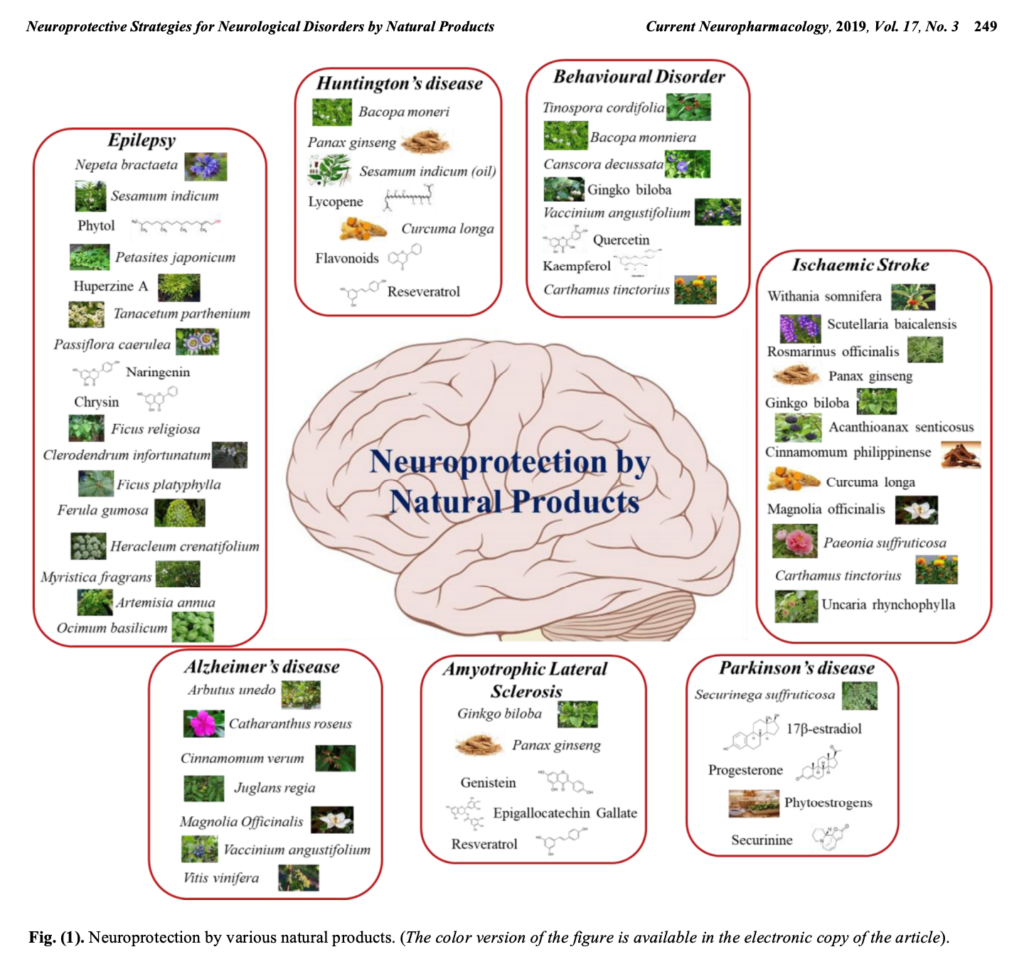
11
‘Smarty Plants’ for Improving Neuroplasticity
Some of the most well-researched botanicals that improve neuroplasticity include: Bacopa monnieri, Crocus sativus, Eleutherococcus senticosus, Camellia sinensis (green tea), Ginkgo biloba, Hypericum perforatum, Olea europaea (olive leaf), Panax ginseng, Rhodiola rosea, Salvia miltiorrhiza, Vitis vinifera, Epimedium (Epimedii Herba) and Withania somnifera.
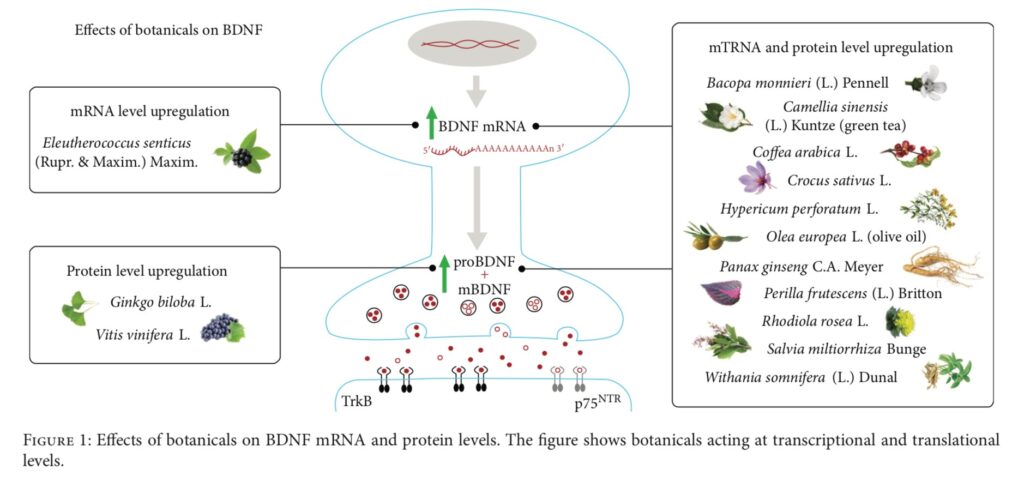
12
Proposed Targets of Botanical Medicine for Improving Neuroplasticity:
- Modulate stress response (HPAA and CNC) and build reserve;
- Modulate common neuroplasticity substrates (neurotrophic signaling, neurogenesis, inflammation and antioxidant defense);
- Increase cerebral blood flow;
- Enhance the innate restoration of anabolic hormones such as testosterone;
- Enhance healthy cell proliferation and increase the number of progenitor cells;
- Epigenetic assistance;
- Improve glucose metabolism and utilization;
- N-Methyl-D-aspartate (NMDA) receptor antagonist;
- Facilitate glutamate breakdown and detoxification; and
- Detoxification, protection and/or mitigation of neurotoxins.
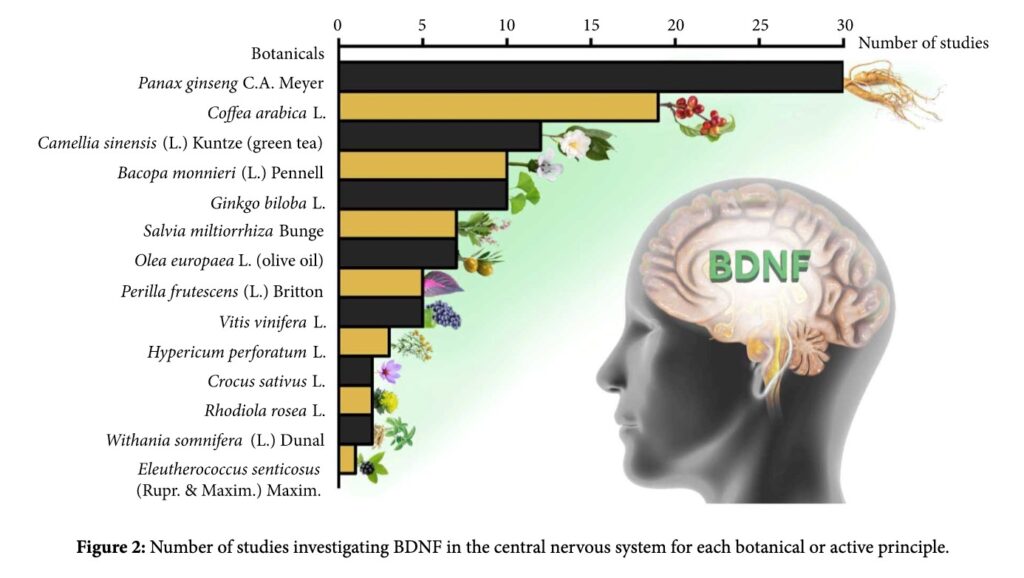
11
Three of My Favorite Plants for Enhancing Neuroplasticity
Bacopa Monnieri (Bacopa)
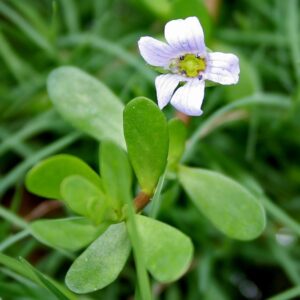
Bacopa is traditionally used in Ayurvedic medicine for epilepsy, asthma and cognitive enhancement. Triterpenoid saponins known as bacosides (bacoside A and B) are considered to be the primary active compounds. Bacopa extract modulates BDNF, which appears to account for its antidepressant and pro-cognitive properties.13-21
Hypericum Perforatum (St. John’s Wort)
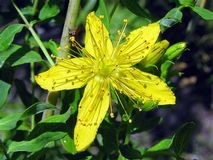
Humble St. John’s wort (Hypericum perforatum) is one of my favorite plant medicines. I consider it a neurological adaptogen because it gently modulates several synaptosomal neurotransmitters, including serotonin, noradrenaline and dopamine, as well as neuronal excitability via glutamatergic and GABAergic mechanisms. Research supports the therapeutic effects of chronic administration of Hypericum perforatum extract (HPE) through morphological adaptations that occur in mature hippocampal neurons during chronic stress, contributing to resiliency.22
The antidepressant activity of HPE was investigated at the preclinical level in two in vivo (animal model) studies. The long-term administration of HPE (350 mg/kg per os, 21 days) significantly reduced mRNA expression of BDNF found in the hippocampus of stressed mice, similarly to the changes elicited by the classically used tricyclic antidepressant drug, Imipramine.23
In a large clinical study, Hypericum extract (HYP) treatment restored the normal protein concentration of BDNF in the serum of depressed patients. This normalization was limited to HYP and serotonin reuptake inhibitors, whereas other classes of antidepressants, including the tricyclics and the noradrenergic and specific serotoninergic antidepressants, were ineffective.24
In another study, Hypericum extract WS 5570, was more effective than paroxetine (Xanax) in patients with a moderate major depressive episode.
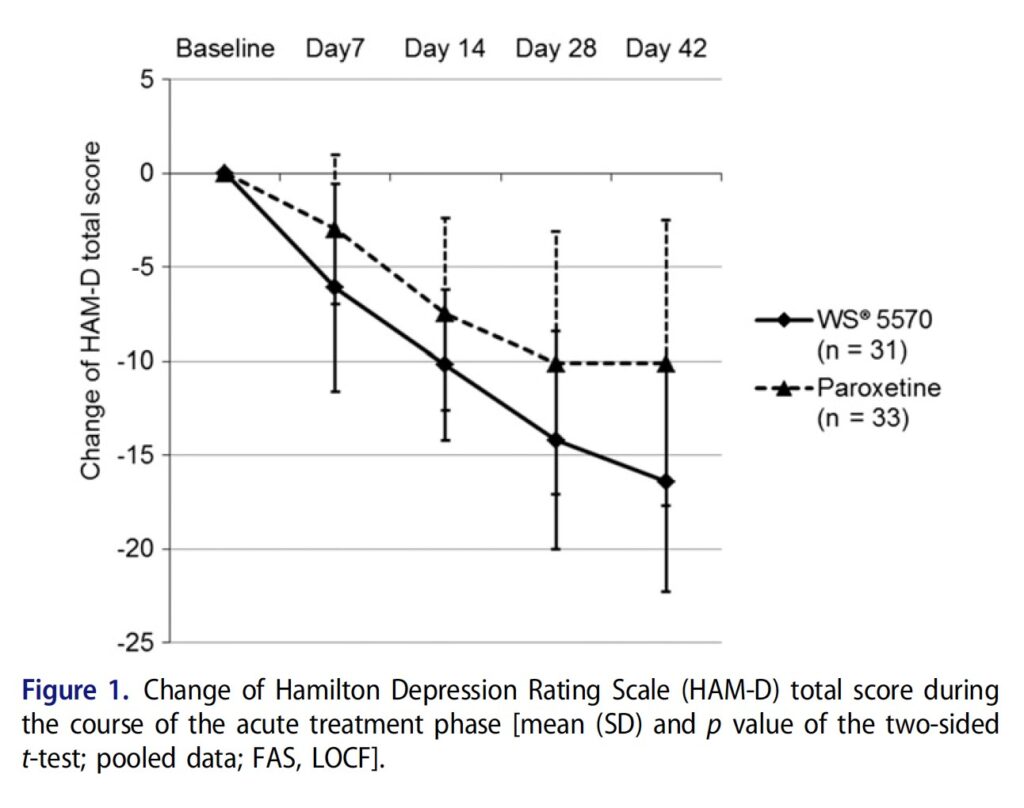
25
In another recent study (a randomized controlled study conducted on 80 postmenopausal women aged 45-60) HPE was found to be very effective for postmenopausal symptoms and depression.26
In addition, a meta-analysis of 27 clinical trials with a total of 3808 patients was performed in 2017 comparing the use of St. John’s Wort with SSRIs. In patients with depression, St John’s Wort demonstrated a comparable response and remission rate, and a significantly lower discontinuation/dropout rate compared to standard selective serotonin reuptake inhibitors.27
Epimedii Herba (Epimedium)

Epimedium (Epimedii Herba) is traditionally used in Chinese medicine to treat kidney yang deficiency. Epimedium has also been used in Korean and Chinese Traditional Medicine to treat hemiplegia (brain injury) following a stroke. To date, many clinical and basic studies of Epimedium have illustrated its activities on functional recovery from brain disease. In addition, Epimedium affects androgen hormones, most notably testosterone, which are known to trigger a vast number of physiological and behavioral responses, including regulation of neuroplasticity factors in the brain’s recovery processes.28,29
In animal studies, icariin, a flavonoid and major constituent of Epimedium, enhanced spatial memory performances and increased expression of hippocampus BDNF.31
In addition, icariin has been shown to reduce dopaminergic neuronal loss and microglia-mediated inflammation in a Parkinson’s disease model.32 Icariin also attenuates neuroinflammation and exerts dopamine neuroprotection via an Nrf2-dependent manner.33
Other Beneficial Adaptogens
Adaptogens such as Panax ginseng and Rhodiola rosea mediate their effects by protecting against excitotoxicity-induced damage and assisting in building neuro-brain resilience.33
In a recent study, twenty-eight healthy volunteers took 500 mg of either Rhodiola rosea extract or a placebo. Rhodiola rosea extract intake increased cortical plasticity and prevented the activity-dependent reduction in efficacy of neuronal synapses. These results suggest that the adaptogenic and antidepressant effects of Rhodiola rosea extract might be based on its brain plasticity effects.34
Diet and Cognitive Well-Being
Population-based studies suggest that diets rich in polyphenols promote better performance in several cognitive abilities in a dose-dependent manner.35
Diets rich in polyphenols have been demonstrated to lower the risk of cognitive decline in older persons. Accordingly, there is growing recognition that bioactive substances in food represent a novel target for lifestyle interventions that may promote healthy brain aging and preserve cognitive function, especially in aging adults at risk for nutritional deficits.36-37
Energy metabolism influences neuronal function and signaling, as well as synaptic plasticity, which ultimately affects mental health. Epigenetic regulation appears to be an important mechanism by which foods can exert prolonged effects on neuronal plasticity. Oxidative stress can damage phospholipids present in the plasma membrane, such as the omega-3 fatty acid DHA (docosahexenoic acid) and disrupt neuronal signaling. Dietary DHA seems crucial for supporting plasma membrane function, interneuronal signaling and cognition.
Diet and exercise contribute to building a cognitive reserve that can be used to support neuronal function and cognition during challenging situations.

Above is a schematic representation of the actions of diet and exercise on neuronal maintenance and repair. Food and exercise influence mitochondrial function, which has resulting effects on synaptic plasticity and the neural substrates for cognition. The interaction of energy metabolism and synaptic functions is pivotal for the regulation of neuronal function and mental health and can involve epigenetic modifications.
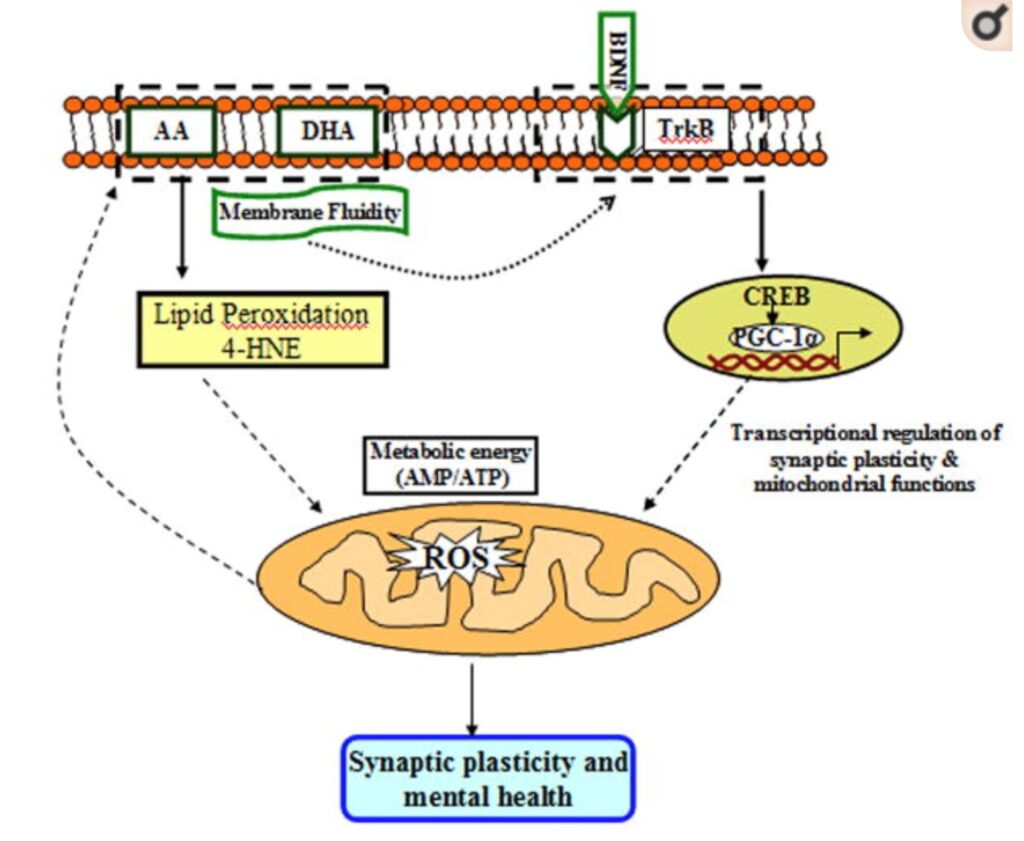
DHA influences neuronal signaling by altering plasma membrane biodynamic or fluidity at synaptic regions. DHA is essential for maintaining plasma membrane integrity, affecting neuronal signaling through receptors embedded in the membrane. The homeostatic interplay between energy management and plasticity in neurons appears crucial for the maintenance of neuronal function and neurological health.38
Nourishing Peace of Mind for a Healthy Brain
Finally, the single most important factor you have control over is your behavior. Unhealthy thought patterns and behaviors not only have short term consequences, but also cause your brain to adapt and become programmed to respond in a specific way to various life situations. Therefore, if you are often stressed and anxious, it could become a normal state-of-being. These behavioral patterns, some of which can be inherited or acquired as a child, are difficult to change. You must change your responses to daily life so that you develop new neural pathways and can more easily access healthy behavior.
Step 1: Become aware
Step 2: Desire to change
Step 3: Pray for internal transformation
Step 4: Implement strategies and techniques to assist you
Pay attention to life and to your responses. Practice deep breathing and other ways of calming your mind. Pray, visualize positive outcome, and believe. Your brain will rewire and become more aligned with Spirit (God within you). With these simple daily practices, you will find love, peace of mind, and kindness can flourish.
References:
- Gwenn S. Smith, PhD, Aging and neuroplasticity, Dialogues Clin Neurosci. 2013 Mar; 15(1): 3–5.
- M. M. Poo, “Neurotrophins as synaptic modulators,” Nature Review Neuroscience, vol. 2, no. 1, pp. 24–32, 2001.
- E. J. Huang and L. F. Reichardt, “Neurotrophins: roles in neuronal development and function,” Annual Review of Neuroscience, vol. 24, no. 1, pp. 677–736, 2001.
- B. Lu, P. T. Pang, and N. H. Woo, “The yin and yang of neurotrophin action,” Nature Review Neuroscience, vol. 6, no. 8, pp. 603–614, 2005.
- Flicker L, Lautenschlager NT, Almeida OP, Healthy mental ageing, J Br Menopause Soc. 2006 Sep; 12(3):92-6, J Am Geriatr Soc. 2015 May; 63(5):938-46.
- Cristy Phillips, Lifestyle Modulators of Neuroplasticity: How Physical Activity, Mental Engagement, and Diet Promote Cognitive Health during Aging, Neural Plast. 2017; 2017: 3589271, Published online 2017 Jun 12. doi: 10.1155/2017/3589271.
- M. Mitre, A. Mariga, and M. V. Chao, “Neurotrophin signalling: novel insights into mechanisms and pathophysiology,” Clinical Science, vol. 131, no. 1, pp. 13–23, 2017.
- A. H. Nagahara and M. H. Tuszynski, “Potential therapeutic uses of BDNF in neurological and psychiatric disorders,” Nature Review Drug Discovery, vol. 10, no. 3, pp. 209–219, 2011.
- S. Yanev, “Neurotrophic and metabotrophic potential of nerve growth factor and brain-derived neurotrophic factor: linking cardiometabolic and neuropsychiatric diseases,” World Journal of Pharmacology, vol. 2, no. 4, p. 92, 2013.
- Stern, Yaakov. “Cognitive reserve in ageing and Alzheimer’s disease.” The Lancet. Neurology vol. 11,11 (2012): 1006-12. doi:10.1016/S1474-4422(12)70191-6.
- Muneeb U. Rehman, Adil Farooq Wali, Anas Ahmad, Sheeba Shakeel, Saiema Rasool, Rayeesa Ali, Shazada Mudasir Rashid, Hassan Madkhali, Majid Ahmad Ganaie, Rehan Khan, Neuroprotective Strategies for Neurological Disorders by Natural Products: An update, Current Neuropharmacology, 2019, 17, 247-267.
- Enrico Sangiovanni, Paola Brivio, Mario Dell’Agli, and Francesca Calabrese, Botanicals as Modulators of Neuroplasticity: Focus on BDNF, Neural Plasticity Volume 2017, Article ID 5965371, 19 pages, https://doi.org/10.1155/2017/5965371.
- R. Banerjee, S. Hazra, A. K. Ghosh, and A. C. Mondal, “Chronic administration of Bacopa monniera increases BDNF protein and mRNA expressions: a study in chronic unpredictable stress induced animal model of depression,” Psychiatry Investigation, vol. 11, no. 3, pp. 297–306, 2014.
- S. Hazra, S. Kumar, G. K. Saha, and A. C. Mondal, “Reversion of BDNF, Akt and CREB in hippocampus of chronic unpredictable stress induced rats: effects of phytochemical, Bacopa Monnieri,” Psychiatry Investigation, vol. 14, no. 1, pp. 74–80, 2017.
- S. Kumar and A. C. Mondal, “Neuroprotective, neurotrophic and anti-oxidative role of Bacopa monnieri on CUS induced model of depression in rat,” Neurochemical Research, vol. 41, no. 11, pp. 3083–3094, 2016.
- B. Czeh, E. Fuchs, O. Wiborg, and M. Simon, “Animal models of major depression and their clinical implications,” Progress in Neuro-Psychopharmacology and Biological Psychiatry, vol. 64, pp. 293–310, 2016.
- X. T. Le, H. T. N. Pham, P. T. Do et al., “Bacopa monnieri ameliorates memory deficits in olfactory bulbectomized mice: possible involvement of glutamatergic and cholinergic systems,” Neurochemical Research, vol. 38, no. 10, pp. 2201–2215, 2013.
- M. D. Pandareesh, T. Anand, and F. Khanum, “Cognition enhancing and neuromodulatory propensity of Bacopa monniera extract against scopolamine induced cognitive impairments in rat hippocampus,” Neurochemical Research, vol. 41, no. 5, pp. 985–999, 2016.
- A. Konar, A. Gautam, and M. K. Thakur, “Bacopa monniera (CDRI-08) upregulates the expression of neuronal and glial plasticity markers in the brain of scopolamine induced amnesic mice,” Evidence-based Complementary and Alternative Medicine, vol. 2015, Article ID 837012, 9 pages, 2015.
- J. Preethi, H. K. Singh, and K. E. Rajan, “Possible involvement of standardized Bacopa monniera extract (CDRI-08) in epigenetic regulation of reelin and brain-derived neurotrophic factor to enhance memory,” Frontiers in Pharmacology, vol. 7, 2016.
- S. S. Patel, N. Mahindroo, and M. Udayabanu, “Urtica dioica leaves modulates hippocampal smoothened-glioma associated oncogene-1 pathway and cognitive dysfunction in chronically stressed mice,” Biomedicine & Pharmacotherapy, vol. 83, pp. 676–686, 2016.
- Crupi et al. Hypericum perforatum treatment: effect on behaviour and neurogenesis in a chronic stress model in mice BMC Complementary and Alternative Medicine 2011, 11:7 http://www.biomedcentral.com/1472-6882/11/7.
- V. Butterweck, H. Winterhoff, and M. Herkenham, “St John’s wort, hypericin, and imipramine: a comparative analysis of mRNA levels in brain areas involved in HPA axis control following short-term and long-term administration in normal and stressed rats,” Molecular Psychiatry, vol. 6, no. 5, pp. 547–564, 2001.
- Erich Seifritz, Martin Hatzinger, Edith Holsboer-Trachsler, Efficacy of Hypericum extract WSVR 5570 compared with paroxetine in patients with a moderate major depressive episode – a subgroup analysis, INTERNATIONAL JOURNAL OF PSYCHIATRY IN CLINICAL PRACTICE, 2016 VOL. 20, NO. 3, 126–132 http://dx.doi.org/10.1080/13651501.2016.1179765.
- J. Preethi, H. K. Singh, J. S. Venkataraman, and K. E. Rajan, “Standardised extract of Bacopa monniera (CDRI-08) improves contextual fear memory by differentially regulating the activity of histone acetylation and protein phosphatases (PP1α, PP2A) in hippocampus,” Cellular and Molecular Neurobiology, vol. 34, no. 4, pp. 577–589, 2014.
- Eatemadnia A, Ansari S, Abedi P, Najar S. The effect of Hypericum perforatum on postmenopausal symptoms and depression: A randomized controlled trial, Complement Ther Med. 2019 Aug;45:109-113. doi: 10.1016/j.ctim.2019.05.028.
- Ng QX1, Venkatanarayanan N2, Ho CY3. Clinical use of Hypericum perforatum (St John’s wort) in depression: A meta-analysis. J Affect Disord. 2017 Mar 1;210:211-221. doi: 10.1016/j.jad.2016.12.048.
- Charlier, Thierry D et al. “Modulation of testosterone-dependent male sexual behavior and the associated neuroplasticity.” General and comparative endocrinology vol. 190 (2013): 24-33. doi:10.1016/j.ygcen.2013.03.003.
- Li F, Gong QH, Wu Q, Lu YF, Shi JS. Icariin isolated from Epimedium brevicornum Maxim attenuates learning and memory deficits induced by d-galactose in rats. Pharmacol Biochem Behav. 2010 Sep;96(3):301-5.
- Wang GQ, Li DD, Huang C, Lu DS, Zhang C, Zhou SY, Liu J, Zhang F. Icariin Reduces Dopaminergic Neuronal Loss and Microglia-Mediated Inflammation and in Vitro, Front Mol Neurosci. 2017; 10:441.
- Zhang B1, Wang G1, He J1, Yang Q1, Li D1, Li J1, Zhang F2. Icariin attenuates neuroinflammation and exerts dopamine neuroprotection via an Nrf2-dependent manner, J Neuroinflammation. 2019 Apr 22;16(1):92. doi: 10.1186/s12974-019-1472-x.
- Jae‐Heung Cho, et. al., Epimedii Herba: A Promising Herbal Medicine for Neuroplasticity, April 2017, https://doi.org/10.1002/ptr.5807.
- Landucci E1, Pellegrini-Giampietro DE1, Bilia AR2, Bergonzi MC2. Enhanced Neuroprotective Effects of Panax ginseng G115® and Ginkgo biloba GK501® Combinations In Vitro Models of Excitotoxicity, Int J Mol Sci. 2019 Nov 22;20(23). pii: E5872. doi: 10.3390/ijms20235872.
- Concerto C, Infortuna C, Muscatello MRA, Bruno A, Zoccali R, Chusid E, Aguglia E, Battaglia F. Exploring the effect of adaptogenic Rhodiola Rosea extract on neuroplasticity in humans. Complement Ther Med. 2018 Dec;41:141-146. doi: 10.1016/j.ctim.2018.09.013.
- Gomez-Pinilla F, Tyagi E. Diet and cognition: interplay between cell metabolism and neuronal plasticity., Curr Opin Clin Nutr Metab Care. 2013 Nov; 16(6):726-33.
- Nurk E, Refsum H, Drevon CA, Tell GS, Nygaard HA, Engedal K, Smith AD, Intake of flavonoid-rich wine, tea, and chocolate by elderly men and women is associated with better cognitive test performance. J Nutr. 2009 Jan; 139(1):120-7.
- Devore EE, Kang JH, Breteler MM, Grodstein F, Dietary intakes of berries and flavonoids in relation to cognitive decline. Ann Neurol. 2012 Jul; 72(1):135-43.
- Gomez-Pinilla F1, Tyagi E. Diet and cognition: interplay between cell metabolism and neuronal plasticity, Curr Opin Clin Nutr Metab Care. 2013 Nov;16(6):726-33. doi: 10.1097/MCO.0b013e328365aae3.


I thoroughly enjoyed this post, especially since I recently had a head trauma/concusion and am in somewhat of a “jumbled” thought processing. I use vibrant mind, Lethicins, DHA and a few other nutritional- my question is what product does Natura have containing Epimediiherba, if any?
thank you
If you are still wondering Ben, it’s the Botanabol….